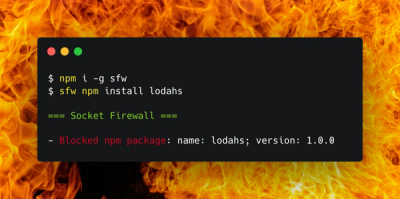
Security News
Package Maintainers Call for Improvements to GitHub’s New npm Security Plan
Maintainers back GitHub’s npm security overhaul but raise concerns about CI/CD workflows, enterprise support, and token management.
A Lox interpreter with tasty TypeScript seasoning
This is my implementation of an interpreter for the Lox language from Robert Nystrom's Crafting Interpreters. I'm building this as part of my Winter 2024 batch at the Recurse Center.
npx gravlax [file.lox]
There's one notable feature I added beyond what's in the text of Crafting Interpreters: support for commas as numeric separators and currencies as first-class values.
You can write 1,234 + 2,456 and gravlax will happily print out 3690.
Note that this has the… interesting side effect of making the grammar whitespace-sensitive:
f(1,2) and f(1, 2) parse differently (the former is a one-argument call).
You can also write out currency values like $123 or €456 and do math on them.
The operations you'd expect to work will work: adding or subtracting values from the
same currency is OK, multiply a currency by a scalar is OK, etc:
> ($1,234 + $2,345) / 10
$357.9
> $12 + €23
MixedCurrencyError: Operands must be the same currency.
Two other niceties:
Support for expressions in the REPL (Chapter 8 Challenge 1).
If you run npx gravlax and then 1+2, it will print 3.
No need to write a print statement.
This makes it possible to use gravlax as a calculator.
The REPL uses readline so you can hit up arrow to get the previous expression and edit it.
Rather than representing AST nodes as classes, I used TypeScript interfaces and
a discriminated union for Expr and Stmt.
This means that we don't need a codegen step.
It also means that we don't need the visitor pattern:
pattern-matching with switch/case is more idiomatic and less code.
While I used a class for the Scanner (same as the book), I used a closure for the parser.
Mostly this just means less writing this dot whatever.
On my machine, gravlax runs the Fibonacci code from Chapter 14 in ~3 minutes (174 seconds). Compare this with 27s for jlox. So we're ~6x slower than Java.
In jlox and gravlax, returning from a function is implemented by throwing an exception.
It's critical that this class not derive from Error, so that it doesn't carry
along stack traces:
- class ReturnCall extends Error {
+ class ReturnCall {
The latter winds up being ~10x faster than the former.
This is the JS equivalent of the weird super(null, null, false, false) call in jlox.
See #37.
pnpm install
pnpm test
pnpm repl
Dan Vanderkam 💻 🖋 📖 🤔 🚇 🚧 📆 🔧 | Josh Goldberg ✨ 🔧 |
💙 This package was templated with
create-typescript-app.
FAQs
A Lox interpreter with tasty TypeScript seasoning
The npm package gravlax receives a total of 23 weekly downloads. As such, gravlax popularity was classified as not popular.
We found that gravlax demonstrated a not healthy version release cadence and project activity because the last version was released a year ago. It has 1 open source maintainer collaborating on the project.
Did you know?

Socket for GitHub automatically highlights issues in each pull request and monitors the health of all your open source dependencies. Discover the contents of your packages and block harmful activity before you install or update your dependencies.

Security News
Maintainers back GitHub’s npm security overhaul but raise concerns about CI/CD workflows, enterprise support, and token management.

Product
Socket Firewall is a free tool that blocks malicious packages at install time, giving developers proactive protection against rising supply chain attacks.

Research
Socket uncovers malicious Rust crates impersonating fast_log to steal Solana and Ethereum wallet keys from source code.